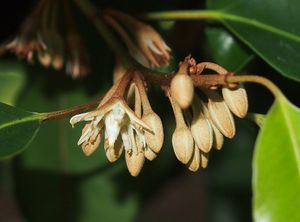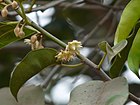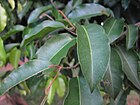Note: This is a project under development. The articles on this wiki are just being initiated and broadly incomplete. You can Help creating new pages.
Difference between revisions of "Mimusops elengi - Bakula, Ranjal"
(→Photo Gallery) |
(→Uses) |
||
| Line 4: | Line 4: | ||
==Uses== | ==Uses== | ||
| − | {{Uses| | + | {{Uses|Diarrhoea}}, {{Uses|Dysentery}}, {{Uses|Gum inflammation}}, {{Uses|Toothache}}, {{Uses|Gonorrhoea}}, {{Uses|Snakebites}}, {{Uses|Fevers}}, {{Uses|Wounds}}, {{Uses|Sore throats}} |
==Parts Used== | ==Parts Used== | ||
Revision as of 12:25, 12 December 2018
Mimusops elengi is a medium-sized evergreen tree found in tropical forests in South Asia, Southeast Asia and northern Australia.
Contents
- 1 Uses
- 2 Parts Used
- 3 Chemical Composition
- 4 Common names
- 5 Properties
- 6 Habit
- 7 Identification
- 8 List of Ayurvedic medicine in which the herb is used
- 9 Where to get the saplings
- 10 Mode of Propagation
- 11 How to plant/cultivate
- 12 Commonly seen growing in areas
- 13 Photo Gallery
- 14 References
- 15 External Links
Uses
Diarrhoea, Dysentery, Gum inflammation, Toothache, Gonorrhoea, Snakebites, Fevers, Wounds, Sore throats
Parts Used
Chemical Composition
DPPH1,1-diphenyl-2-picrylhydrazylABTS2,2′-azino-bis(3-ethylbenzthiazoline-6-sulphonic acid)MTT3-(4,5-dimethylthiazol-2-yl)-2,5-diphenyltetrazolium bromide[1]
Common names
| Language | Common name |
|---|---|
| Kannada | Ranjal |
| Hindi | Maulsari |
| Malayalam | Ilanni |
| Tamil | Magizhamboo |
| Telugu | |
| Marathi | NA |
| Gujarathi | NA |
| Punjabi | NA |
| Kashmiri | NA |
| Sanskrit | |
| English | Spanish cherry |
Properties
Reference: Dravya - Substance, Rasa - Taste, Guna - Qualities, Veerya - Potency, Vipaka - Post-digesion effect, Karma - Pharmacological activity, Prabhava - Therepeutics.
Dravya
Rasa
Kashaya (Astringent), Katu (Pungent)
Guna
Guru (heavy)
Veerya
Sheeta (cold)
Vipaka
Katu (Pungent)
Karma
Kapha, Pitta
Prabhava
Habit
Identification
Leaf
| Kind | Shape | Feature |
|---|---|---|
| Simple | alternate | Petiole 1-2.5 cm long, glabrous, terete and canaliculate towards apex |
Flower
| Type | Size | Color and composition | Stamen | More information |
|---|---|---|---|---|
| Unisexual | 2-4cm long | white | 5-20 | Flowers white, in axillary fasicles |
Fruit
| Type | Size | Mass | Appearance | Seeds | More information |
|---|---|---|---|---|---|
| Berry | 7–10 mm | Berry, ellipsoid, reddish-brown when ripe | single | {{{6}}} |
Other features
List of Ayurvedic medicine in which the herb is used
- Vishatinduka Taila as root juice extract
Where to get the saplings
Mode of Propagation
How to plant/cultivate
A plant of the hot tropical lowlands[335 ]. It thrives in areas with perhumid or slightly seasonal rainfall types, but is most commonly found in seasonally dry habitats[3]
Commonly seen growing in areas
Tall grasslands, meadows, Borders of forests and fields.
Photo Gallery
References
External Links
- Ayurvedic Herbs known to be helpful to treat Diarrhoea
- Ayurvedic Herbs known to be helpful to treat Dysentery
- Ayurvedic Herbs known to be helpful to treat Gum inflammation
- Ayurvedic Herbs known to be helpful to treat Toothache
- Ayurvedic Herbs known to be helpful to treat Gonorrhoea
- Ayurvedic Herbs known to be helpful to treat Snakebites
- Ayurvedic Herbs known to be helpful to treat Fevers
- Ayurvedic Herbs known to be helpful to treat Wounds
- Ayurvedic Herbs known to be helpful to treat Sore throats
- Herbs with Dried Folaige used in medicine
- Herbs with Whole herb used in medicine
- Herbs with common name in Kannada
- Herbs with common name in Hindi
- Herbs with common name in Malayalam
- Herbs with common name in Tamil
- Herbs with common name in English
- Habit - Evergreen Tree
- Index of Plants which can be propagated by Seeds
- Index of Plants which can be propagated by Cuttings
- Herbs that are commonly seen in the region of Tall grasslands
- Herbs that are commonly seen in the region of meadows
- Herbs that are commonly seen in the region of Borders of forests and fields
- Herbs








